BARE-RIFE TUBE HINTS
Unless the Rife operator is also the test subject, it is typically advantageous to have the high power Rife tube located somewhat remotely from the equipment and closer and more conveniently toward the test subject. Selected location should be such that the operator can easily view the tube at its remote location to verify effective and proper operation.
Over the years I have heard many folks speak of RF interference (i.e. with their stereo, TV, or even worse, to the computer or function generator they may be using as a control device. I have even seen the stray RF loop back thru the equipment effectively destroying the radio and amplifier and yes . even the tuner, which is incredibly hard to do.
I have never personally experienced this to be a problem on any of my equipment, however, over the years I have personally witnessed all of the above. In assisting other experimenters, in every case, without exception, the issues stemmed from poor workmanship, inferior components, and a general lack of knowledge or background to know the difference or be able to identify the actual problem. Hopefully these notes will assist experimenters and researchers in preventing these situations.
RF leakage and interference does NOT need to be a problem. Quality cabling and an effective wrap, helps insure efficient delivery of the RF into the Nobel gas which then effectively absorbs the RF to bring the atomic particles to a level of excitement which they themselves begin giving off sub-particles (another word)???. Among others things, we witness the measurable bi-products, light and a mild magnetic field.. Neither of which is likely to be the "effective ingredient" in our application, but both offer clear evidence of what is occurring at the atomic level. An efficiently operating plasma tube actually emits very little RF energy. In an ideal world, it emits NONE.
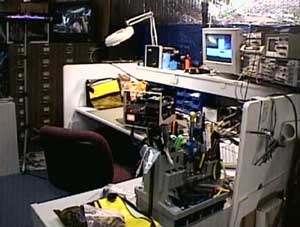
Shown operating here near a TV, this large tube is actually connected to a cable 18ft in length. The free standing tube shown here is easily adjustable in height. This is preferable to having the tube within close proximity of other grounded metal equipment which can adversely affect efficient delivery into the tube and overall performance. Note tube in operation, (appx. 150watst indicate***s), within close proximity of TV (appx 3 to 4'). Outdoor antenna, (not seen in photo), is also appx. 4' from plasma tube. Close ups here show no perceivable interference to TV or computer.
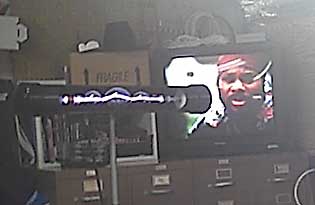
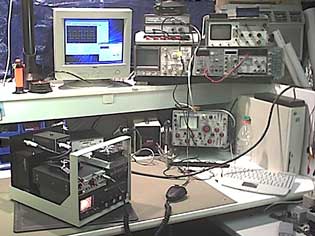
Although NOT within the scope of these notes, the physics of plasma can be quite complex . and immensely interesting. But suffice to say, the RF "carrier" is not what "transmits" the signal to your subject's body, but rather is only the medium by which the controlled signal is delivered into the plasma.
Direct Connection at Equipment (Balanced Line Output)
If you are connecting the tube directly at the equipment, use equal length short leads (appx. 16-18 inches, or less, with as many strands as possible. The electron flow along this wire in on the outside surface of the copper. Finer strands and lots of them increases drastically the surface area available for the electron flow.
[photo of tube connected to back of unit]
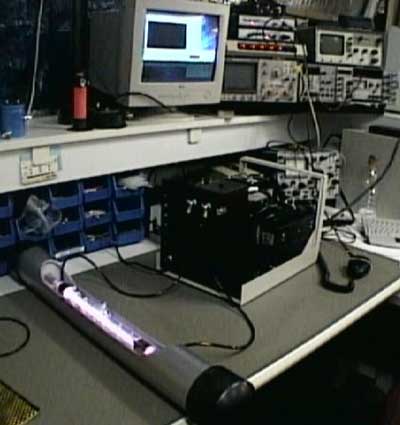
A Few General Rules
- Use QUALITY components ... don't use Radio Shack components unless you have no other options. Their prices are very high and quality VERY LOW!
- Over-rate wherever possible. I do NOT recommend the use of RG-8 cable AT ALL. Instead use the heavier and less manageable but significantly less signal loss RG-213, RG-214 or ideally if you can get it RG-616???.** The lengths we are talking about here will generally not greatly impact your budget and decent quality cable can be obtained at less that typical "Radio Shack" prices.
- Order the wire and connectors from a reputable online firm. In my opinion, cable perfectly fine for normal CB operation, is just not good enough when the wide bandwidth signal we are sending thru it is present.
- Use the shortest cables possible for your interconnections. Plan your component layout accordingly. Most of my connections are typically 10 or 12 inches, "tip to tip".
- Understand the tubes and tube types before you make your selection. Select the most appropriate tube for YOUR use and your equipment configuration.
* An effective tube wrap method for Bare-Rife is located in the Reference/Construction Aids Area of the Introduction to Rife Technology Website www.holman.net/rifetechnology
** Basic RG-8 typically has only the simple ground braid and may only have one or only a few strands for the center conductor. As cable quality increases, extra layers of ground foil are added, extra center strands added, signal loss and quality increases dramatically.
Additionally, the highest quality cables may have additional outside jacket layers. As the additional shield layers are added the cable becomes quite stiff with little flexibility. As we are often connecting withing confined areas, RG-213 and RG-214 is typically an excellent choice. If you have a long run such as to your remote tube you should use the very best cable available.
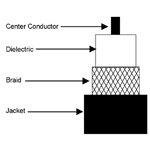
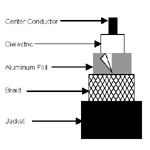
*** There is good reason to believe that the power indicated in a Bare-Rife system may not be accurately measuring or indicating in patented system. This however should not be a problem or concern of most individuals. There have been technical papers presented that discuss this in more detail than is applicable here. Will try to make them available at a future date.

